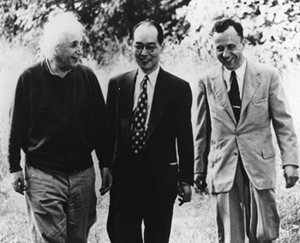The Scientific Legacy of John Wheeler
On Saturday morning, 2 May 2009, about 200 rapt listeners attended a Forum session, chaired by James Hartle of UC Santa Barbara, devoted to the legacy of John Wheeler. All three speakers—Kenneth W. Ford (former chief executive officer of the American Institute of Physics), Kip S. Thorne of Caltech, and Wojciech H. Zurek of Los Alamos—worked with Wheeler as graduate students and/or postdocs during three major phases of his career: nuclear and particle physics; black holes and gravitation; and information theory. (See the special issue of Physics Today on Wheeler, April 2009, featuring extensive articles by these authors.)

Photo by Wallace Litwin and Josef Kringold, courtesy AIP Emilio Segré Visual Archives, Wheeler Collection.
Albert Einstein, Hideki Yukawa, and John Wheeler outdoors in Marquand Park, Princeton (1954).
Ford launched the session with a talk titled "John Wheeler, 1933-1959: Particles and Weapons." Ford mentioned Wheeler's postdoctoral work, under Bohr at Copenhagen, on the liquid-drop model of the nucleus. That work was followed by their famous 1939 paper on nuclear fission, which was written during Bohr's visit to Princeton that year ("The Mechanism of Nuclear Fission," Phys. Rev. 56, 426). During the 1940s, Wheeler worked on the theory of positronium and served as Feynman's thesis adviser. Later that decade Wheeler originated the idea of a universal Fermi interaction, with a single weak-interaction coupling constant, and foreshadowed the possibility of a distinctive muon-type neutrino. In the last part of his talk, Ford noted Wheeler's defense work, first at the Hanford Lab during the Manhattan Project, where he helped to diagnose and solve the problem of Xe-135 poisoning of the nuclear pile. Following the War, at Edward Teller's urging Wheeler joined the hydrogen bomb effort in 1950, and in the mid-1950s co-founded (with Lyman Spitzer) Project Matterhorn at Princeton to perform computer simulations of nuclear fusion, on which Ford worked as his graduate student (the other branch of Matterhorn grew into the Princeton Plasma Physics Laboratory; see Ford's article "Working (and Not Working) on Weapons," Radiations Spring 2005).
Kip Thorne spoke next on "John Archibald Wheeler, 1952-1976: Black Holes and Geometrodynamics." In 1952, Wheeler decided to strike out in a completely new direction and took up the study of general relativity, teaching a course on the subject at Princeton as one way to learn about it. Strange new concepts such at the "geon," a gravitationally bound electromagnetically interacting particle, the "black hole," and the "wormhole" convinced him of the richness that nonlinearities can produce in curved space-time. According to Thorne, Wheeler also was the first to recognize the Planck length of 10-33 cm as the scale where quantum effects would become important in general relativity. In 1957 he coauthored a paper with Joseph Weber titled, "Reality of the Cylindrical Gravitational Waves of Einstein and Rosen" (Rev. Mod. Phys. 29, 509). And of course there is the famous textbook Gravitation, first published in 1973, that Wheeler co-authored with Thorne and Charles Misner. This book and other works by Wheeler pioneered the study of what he dubbed "geometrodynamics"- the dynamics of curved space-time.
Zurek, who was Wheeler's graduate student and postdoc during the late 1970s and early 1980s at the University of Texas, closed the session with his presentation "John Wheeler, 1976-1996: Law Without Law and Quantum Information." During his Texas period, Wheeler turned his attention to the quantum measurement problem—the role of the observer in defining what "is." In this research, said Zurek, Wheeler followed what he called the principle of "radical conservatism," adhering to well-established physical principles while pushing them into extreme situations—an intellectual tendency Wheeler attributed to Bohr. As described in Quantum Theory and Measurement (edited by Wheeler and Zurek, Princeton Univ. Press,1983), Zurek said that the observer confers "reality" on the past by observing it, and offered the Big Bang as an example. "What do we mean by 'reality' except the results of observations?" he asked.
The session ended with a segment of a videotaped interview with Wheeler, in which he stated, "Philosophy is too important to be left to the philosophers." It was obvious to all attendees that the three speakers were sharing not only the work of a great physicist. They were also paying homage to their friend. Even those who did not know John Archibald Wheeler personally came away uplifted.
Note Added: This article represents the views of the author, which are not necessarily those of the FHP or APS.
